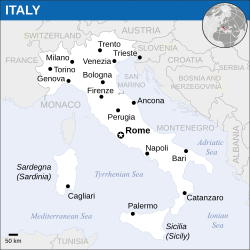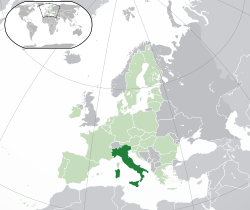User:Alba0521/sandbox
Italian Republic Repubblica Italiana (Italian) | |
|---|---|
Location of Alba0521/sandbox (dark green) – in Europe (light green & dark grey) | |
 | |
| ISO 3166 code | IT |
Introduction[edit]
Italians live under an immersed communicative environment where people like communicate with each other in their body languages, especially hand gestures. The use of hand gestures not only set up an interaction between the speakers and listeners but express themselves thoroughly in the Italian language system. There are plenty of basic and useful gestures used in normal Italian chats, such as finger purse, finger kiss, prayer clasp, temple point, etc. Therefore, this kind of manual communication significantly reduces the language barriers which promotes multicultural communication, based on the fact that Italy is located in the coastline of the Mediterranean Sea where is a communication center.
History[edit]
Origins[edit]
The development of hand gesture is closely connected with the communicative phenomena [1]. And this non-verbal communication system cannot be formed within a short period. The early urbanization in Italy is believed to be the seed of capitalism which creates more opportunities for negotiations and bargains [2]. The increasing demand of communication stimulates the widely use of hand gestures in Italy. In addition, the colonization stimulates the culture fusion leading to the need of another language to communicate, hand gestures. According to research, the time that Ancient Greek colonized along the Mediterranean coast including the southern Italy, could be traced back to the early eighth century BC (Rathmann, Saltini Semerari, & Harvati, 2016)[3]. Based on the extant funeral stone from the 5th century BC in the Pergamon Museum in Berlin, two soldiers were recorded with the moment of hands shaking [4]. And this is believed to be the proof of gestures in Ancient Greek which passes to and affected the Italian non-verbal conversations generations to generations even more than language. Until now, it has been identified around 250 hand gestures Italian used in everyday conversation[5].
Renaissance[edit]
The irreplaceable role of gesture in medieval societies especially in Renaissance is being acclaimed as the ‘une civilisation du geste’ by Jacques Le Goff[6]. One reason that can explain the rich history of Italian hand gestures and one of them is about the cultural transmission and emotional expression during the period of Renaissance. Renaissance emphasized the restoration of human nature in the classical era with the aim of breaking the shackles of religion[7] . At that time period, people have stronger willing to express themselves and attract the attention from other people with the aim of humanity liberation[8] . By using hand gestures, they can gain a sense of satisfaction from delivering their thoughts. Therefore, Renaissance is a vial time point for the development of Italian hand gestures.
Classification of Italian hand gestures[edit]
It is demonstrated that hand gestures have been widely used in different occasions such as religious rites, gladiatorial arenas and daily routine[9] in ancient Italian history or present.
Religious Rites[edit]
In the oldest surviving Annunciation image,icons of the Annunciation, it can be found that the Archangel Gabriel is generally raised his hand before he started to mention something important. And this kind of gesture had been amply manifested by the behaviors of Roman rhetoricians when they were about to emphasis a key point[10]. Until now, this kind of tradition still affects the conversation of Italians to begin a exordium.
Gladiatorial Arenas[edit]
More recent researches suggest that the use of thumb up and thumb down originates from Rome in the gladiatorial arenas, to decide the destiny of the loser in that fight[11]. The loser may beg for mercy to the crowded who would decide the fate of him by showing thumbs up or down. If he received more thumbs-up gesture than the thumbs-down, them this gladiator was to be alive. Thumbs down, on the other hand, signified execution[12]. However, there is still a controversial around scholars about the exact meaning of thumb-up and thumb-down in ancient Rome.
Daily Routine[edit]
The habit of talking with one’s hands in Italy has been reported to address and reinforce the meaning of expressions. An icon symbol of Italian gesture is the movement of hand with an up-down activity.
Basic Postures in Conversation[edit]
The following section introduces introduce the 10 common and useful gestures used in Italian conversation with pictures attached [13].
Finger purse (Ma che vuoi)[edit]
Keep your fingers together, with tips touching and pointing upward. Arm is about a foot distance away from the body. Hands can move up and down at the wrist or be held.
English meaning: What do you mean?
Prayer clasp (Ti prego)[edit]
Put your palms devoutly and press them in front of the chest.
English meaning: Would you please do me a favor?
Finger kiss (Eccellente)[edit]
Bunch ten fingers together and lift them to the same height as mouth. Then use hand to touch the lips.
English meaning: Excellent.
A line in the air (Perfetto)[edit]
The thumb and index finger form a circle, with the other three fingers extended and draw a straight line horizontally.
English meaning: Perfect.
Cheek screw[edit]
Put one index finger on the cheek.
English meaning: Delicious.
Eyelid pull (Stai attent)[edit]
Using your index finger, tugging at your bottom eyelid.
English meaning: Watch out!
Finger cross[edit]
Form and X in front of the chest by using two index fingers.
English meaning: I swear it!
Circle in the air (A dopo)[edit]
Use one one index finger and extend it to draw a small circle in the air.
English meaning: See you later.
Spaghetti (Spaghettata)[edit]
Index and middle finger imitate a fork picking up spaghetti and turn the elbow downwards.
English meaning: Eat spaghetti.
References[edit]
- ^ Blake, Joanna; Vitale, Grace; Osborne, Patricia; Olshansky, Esthe (2005). A Cross-Cultural Comparison of Communicative Gestures in Human Infants during the Transition to Language. pp. 201–217. ISSN 1568-1475.
- ^ Attema, P. A. J (2004). Centralization, early urbanization, and colonization in first millenium B.C.Greece and Italy. Leuven ; Dudley, MA : Peeters.
- ^ Rathmann, H.; Semerari, G. Saltini; Harvati, K. (2017). "Evidence for Migration Influx into the Ancient Greek Colony of Metaponto: A Population Genetics Approach Using Dental Nonmetric Traits". International Journal of Osteoarchaeology. 27 (3): 453–464. doi:10.1002/oa.2569. ISSN 1099-1212.
- ^ "From the handshake to the high-five: a brief history of gestures". History Extra. Retrieved 7 May 2019.
- ^ Brennan, Linda L. (2000-09). "Let Your Fingers Do the Talking: Conducting Class with "Chat"". Journal of Educational Technology Systems. 29 (1): 21–30. doi:10.2190/5qgv-efkp-9ygl-kqfa. ISSN 0047-2395.
{{cite journal}}: Check date values in:|date=(help) - ^ Le Goff, Jacques, 1924- Schmitt, Jean Claude, ed. Revel, Jacques, 1942- ed. Augé, Marc. (1998). L'Ogre historien : autour de Jacques Le Goff. Gallimard. ISBN 2070750892. OCLC 803411090.
{{cite book}}: CS1 maint: multiple names: authors list (link) CS1 maint: numeric names: authors list (link) - ^ "The Italian View of Renaissance Italy", Renaissance Essays, Bloomsbury Academic, ISBN 9781472599735, retrieved 7 May 2019
- ^ S. Celenza, Christopher (2013-01). "What Counted as Philosophy in the Italian Renaissance? The History of Philosophy, the History of Science, and Styles of Life". Critical Inquiry. 39 (2): 367–401. doi:10.1086/668530. ISSN 0093-1896.
{{cite journal}}: Check date values in:|date=(help) - ^ Corbeill, Anthony, author. Nature Embodied : Gesture in Ancient Rome. ISBN 9780691187808. OCLC 1076414916.
{{cite book}}:|last=has generic name (help)CS1 maint: multiple names: authors list (link) - ^ Esparza, Daniel (12 June 2016). "What Do the Hand Gestures in Icons Mean?". Aleteia — Catholic Spirituality, Lifestyle, World News, and Culture. Retrieved 7 May 2019.
- ^ Corbeill, Anthony (1997). "THUMBS IN ANCIENT ROME: "POLLEX" AS INDEX". Memoirs of the American Academy in Rome. 42: 1. doi:10.2307/4238745. ISSN 0065-6801.
- ^ "V. From Eternity to Five-Year Plans", A Very Brief History of Eternity, Princeton University Press, ISBN 9781400831876, retrieved 7 May 2019
- ^ gonomadtravel (1 June 2010). "Italian Hand Gestures in Conversation". GoNOMAD Travel. Retrieved 7 May 2019.





